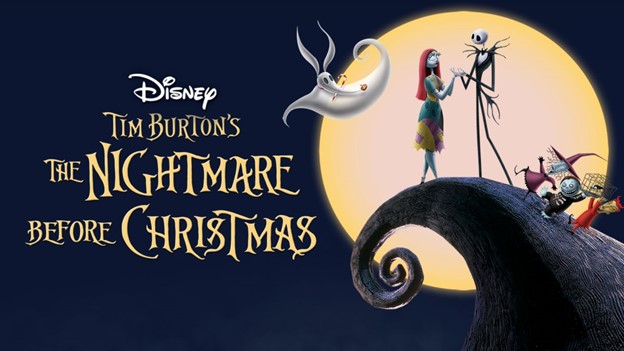
To listen to this reflection as a podcast, click here.
Throughout the season of Advent – which this year encompasses the four weeks leading up to December 25 – we’re looking at classic Christmas movies and how they might connect us to the miracle of God choosing to become a human being.
Christmas movies come in all shapes and sizes. Some are quite simply in a class by themselves.
That’s an accurate way to describe The Nightmare Before Christmas, a 1993 stop-motion animated labor of love by writer and producer Tim Burton. Disney was so anxious about what would appear on the screen that the company released the film through Touchstone Pictures, their “grown-up” subsidiary, just in case the movie was “too dark and scary for kids.”
Nightmare did not generate a great deal of profit or become a global hit. But it has steadily gained cult classic status. Its millions of devotees cannot imagine Christmas without it.
In Burton’s playful fantasy world, different holidays are represented by different towns. They have their own citizens, traditions, and even weather. Jack Skellington, one of the ghoulish residents of Halloween Town, pays a visit to Christmas Town. He’s blown away by the rituals and virtues associated with December 25. They are utterly different from those aligned with October 31.
After Jack tries (unsuccessfully) to figure out what makes Christmas tick, he opts for a bold plan. He will improve Christmas. He’ll make it more like Halloween.
He authorizes some of his minions to kidnap Santa Claus (or “Sandy Claws,” as Jack calls him). That leaves Jack free to institute a whole new tradition of delivering presents on Christmas Eve. He flies from chimney to chimney on a sleigh pulled by skeletal reindeer. Suffice it to say, children are less than thrilled to receive live snakes and toys that attack them. Check out the scene here: The Nightmare Before Christmas(1993) – Jack Delivers Terrifying Presents – YouTube
Jack ultimately realizes that instead of improving Christmas he has turned it into, well, a nightmare. He liberates Santa just in time to save the day.
The real magic of the film is Burton’s devotion to the stop-motion craft. Charmed by his memories of Rudolph the Red-Nosed Reindeer on TV when he was a child, Burton set out to do what no one had ever pulled off before: generating a full-length feature film by painstakingly manipulating each of his characters for every new scene.
Filming took two years and 20 animation stages. Since there are 24 frames per second in a standard roll of film, the animators had to create more than 100,000 separate frames. Each character had dozens of variations of ears, eyes, and smiles which could be snapped into place as their expressions changed. Jack Skellington himself donned 400 different heads.
The result is a movie that is a million miles from It’s a Wonderful Life. But it’s also, in the words of critic Peter Travers, “74 minutes of timeless movie magic.”
Does Jack Skellington experience his own moment of transformation concerning the true meaning of Christmas? He does. “In my bones I feel the warmth that’s coming from inside” – which, when you think about it, is pretty high praise coming from a skeleton. He’s also delighted to discover that Christmas Town is a place where children “throw snowballs instead of heads.”
Is The Nightmare Before Christmas a Halloween movie or a Christmas movie? It’s a bit of both. The folks at Rotten Tomatoes have made it clear that they side with those who prefer the December holiday, ranking Nightmare #1 on its list of “Top 25 Best Christmas movies.”
Jack is obsessed with creating a “new and improved” Christmas. Those three words are the standard way to market anything on the cutting edge in the modern world.
Every year theme parks have to deliver roller coasters that are newer, scarier, and cooler. Applebee’s, Chipotle, and Burger King have to keep coming up with new edible reasons for us to give them our business. Thousands of magazines are published in the US every month, many of which promise new secrets to achieve happiness, new ways to make money, and new strategies to live the dream life you’ve always wanted to live.
Places of worship are not immune to such pressure. What we really need is a new praise team and a new series on spiritual growth – one that’s “deeper” and “more authentic” than any of our previous experiences.
Most fearsome of all is the pressure on relationships. If my partner no longer takes my breath away, we probably need a new vacation or a newly remodeled kitchen. Or maybe I just need a new partner. Less-than-thrilling people need not apply.
In Bible times, however, new and improved would have backfired.
The most highly valued products and services were the traditional ones – the ones that had been tested and refined by generations of artisans and craftsmen. The wisdom of the elders was almost always considered superior to novel ideas.
In our ongoing quest for the new, the better, and the best, we foolishly take for granted the gifts that God has already given to us: the job that pays our bills; the loved ones who truly do love us; the physical health that sustains us.
No wonder the apostle Paul wrote – so contrary to the spirit of our times – “Be thankful in every circumstance” (I Thessalonians 5:18).
We can always be thankful, or we can spend the rest of our lives trying always to one-up whatever we did last year.
Jack Skellington discovers that the world doesn’t really need a new and improved Christmas.
The one we already have is awesome enough.
